Chapter 9
Diesels For Dummies
In This Chapter
 Weighing the advantages and disadvantages of diesel-powered vehicles
Weighing the advantages and disadvantages of diesel-powered vehicles
 Exploring diesel fuel, electrical, and exhaust systems
Exploring diesel fuel, electrical, and exhaust systems
 Troubleshooting and maintaining diesel engines
Troubleshooting and maintaining diesel engines
 Starting a diesel when it’s cold outside
Starting a diesel when it’s cold outside
 Identifying a good diesel mechanic
Identifying a good diesel mechanic
Think of this chapter as a mini-version of Auto Repair For Dummies devoted entirely to diesel-powered vehicles. It explores the new generation of clean diesel vehicles and explains how diesel engines work. It also provides instruc-tions for maintaining and troubleshooting diesel-powered vehicles and for finding a good diesel mechanic when your best efforts just aren’t enough.

Clean Diesels: Nontoxic Newcomers
Diesel-powered vehicles are popular in the large part of the world where gasoline is very expensive or almost unavailable. In the United States and Canada, up until recently diesel engines were found mainly in heavy equipment, large trucks, buses, heavy-duty pickup trucks, and boats. Diesel- powered passenger vehicles existed, but they had a reputation for being noisy, underpowered, smelly, and carcinogenic. For a short period in the 1980s people overlooked those negatives when fuel shortages made diesel-powered vehicles popular because they got 25 percent more miles per gallon than gasoline engines and diesel fuel was less expensive than gasoline. They soon fell out of favor because major carmakers dropped diesel engines into vehicles that weren’t equipped to withstand the higher stress these engines imposed.

As fuel prices rise and nations compete (sometimes violently) for dwindling sources of oil, efficiency and power are excellent reasons for replacing your gas-guzzler with a vehicle that saves you money because it goes farther on less fuel and gives you the satisfaction of knowing that you’re doing your bit to protect the environment.
|
Figure 9-1: A clean diesel vehicle. |
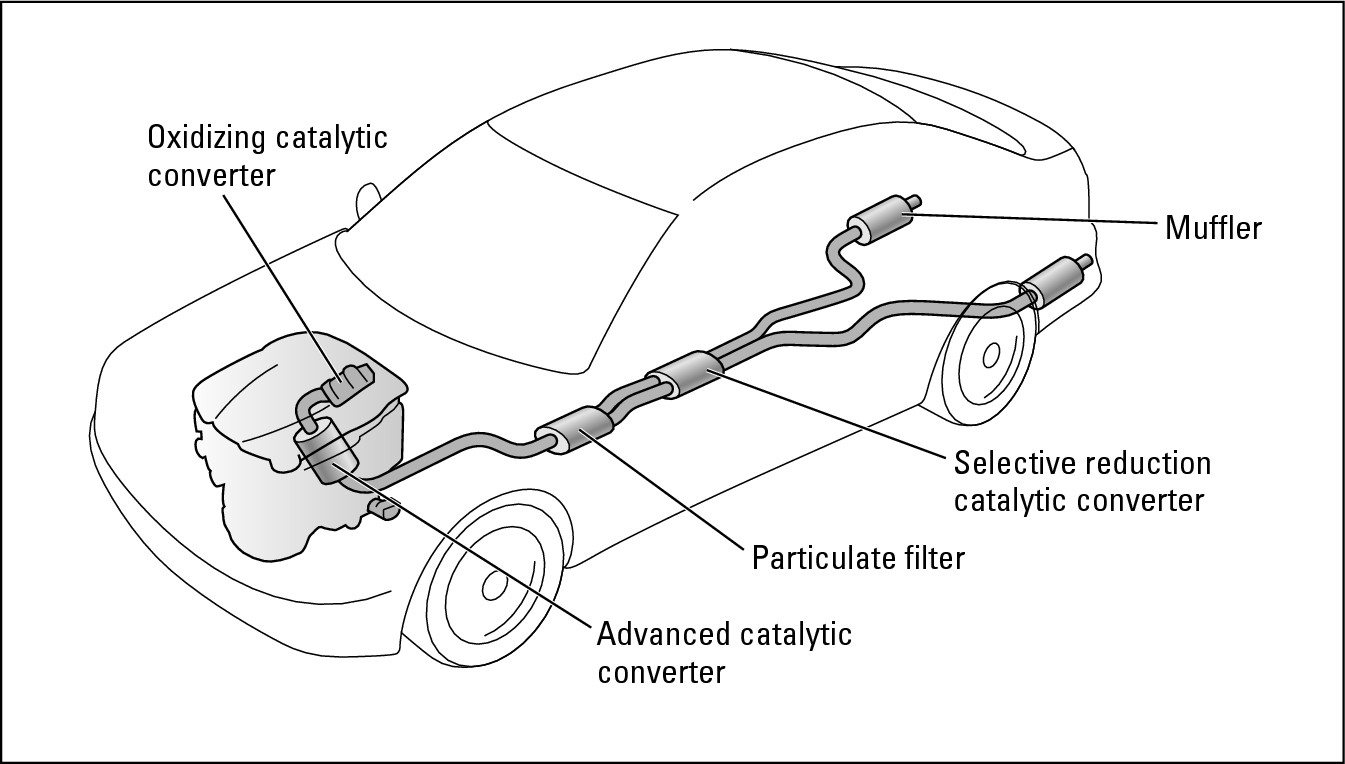
|
The Pros and Cons of Diesels
If you’re considering buying a new set of wheels, take a good look at this chapter on the new clean diesels as well as the alternatively fueled vehicles that I cover in Chapter 10 before you decide what to buy. This section helps you weigh the advantages and disadvantages of diesel-powered vehicles.

PRO: Diesels get great mileage. This is true; they typically deliver 25 to 30 percent better fuel economy than similarly performing gasoline engines. Diesels also can deliver as much or more fuel economy than traditional gasoline-electric hybrids, depending on the models involved and whatever rapidly developing automotive technology achieves.
CON: Although diesel fuel used to be cheaper than gasoline, it now often costs the same amount or more. Diesel fuel is also used for commercial trucks, home and industrial generators, and heating oil, so as demand for diesel passenger vehicles grows, the price of diesel fuel is likely to continue to rise because of competition from those other users.
BUT: Even if the price goes up, diesel fuel would have to be 25 to 30 percent more expensive than gas to erase the cost advantage of a diesel engine’s greater fuel efficiency.
PRO: Diesel fuel is one of the most efficient and energy dense fuels available today. Because it contains more usable energy than gasoline, it delivers better fuel economy.
CON: Although diesel fuel is considered more efficient because it converts heat into energy rather than sending the heat out the tailpipe as gas-powered vehicles do, it doesn’t result in flashy high-speed performance. In some ways, a gasoline-powered engine is like a racehorse — high-strung, fiery, and fast — whereas a diesel engine is more like a workhorse — slower, stronger, and more enduring.
BUT: Because of the way it burns fuel, a diesel engine provides far more torque to the driveshaft than does a gasoline engine. As a result, most modern diesel passenger cars are much faster from a standing start than their gas-powered counterparts. Diesels with manual transmissions usually don’t have to be downshifted to easily pass other vehicles on the highway, and although they don’t reach the highest speeds of gasoline-powered cars, many diesels still can cruise quite handily at 100 miles per hour or more (providing you can find a place to do that legally!). What’s more, diesel-powered trucks, SUVs, and cars also can out-tow gas-powered vehicles while still delivering that improved fuel economy.
PRO: Diesels have no spark plugs or distributors. Therefore, they never need ignition tune-ups.
CON: Diesels still need regular maintenance to keep them running. You have to change the oil and the air, oil, and fuel filters. Cleaner diesel fuels no longer require you to bleed excess water out of the system, but many vehicles still have water separators that need to be emptied manually.
PRO: Diesel engines are built more ruggedly to withstand the rigors of higher compression. Consequently, they usually go much longer than gas-powered vehicles before they require major repairs. Mercedes-Benz holds the longevity record with several vehicles clocking more than 900,000 miles on their original engines! You may not want to hang onto the same vehicle for 900,000 miles, but longevity and dependability like that can sure help with trade-in and resale values.
CON: If you neglect the maintenance and the fuel injection system breaks down, you may have to pay a diesel mechanic more money to get things unsnaggled than you would to repair a gasoline system because diesel engines are more technologically advanced.
BUT: All types of vehicles need maintenance, and the increasing complexity of both traditional and alternative vehicles may require repair by specialized technicians that work at higher rates than the mechanics at your neighborhood garage.

What Makes It Go?
The basic difference between a diesel engine and a gasoline engine is that in a diesel engine, the fuel isn’t ignited by an outside power source like a spark plug. Instead, the fuel is sprayed into the combustion chambers through fuel injector nozzles just when the air in each chamber has been placed under such great pressure that it’s hot enough to ignite the fuel spontaneously. (You can find more-detailed information about this process in the later section “The diesel four-stroke power cycle.”)

Following is a step-by-step view of what happens when you start up a diesel-powered vehicle. In the later section “The diesel four-stroke power cycle,” you take a closer look at each step of the power cycle that converts all this into power to drive the vehicle.
The following details may vary from one vehicle to another, but the action remains pretty much the same. (You may find it fun to compare this description with the short overview of how internal combustion engines work in Chapter 4.)
1. When you first turn the key in the ignition, you’re asked to wait until the engine builds up enough heat in the cylinders for satisfactory starting. (Most vehicles have a little light that says “Wait,” but a sultry computer voice may do the same job on some vehicles.) Turning the key begins a process in which fuel is injected into the cylinders under such high pressure that it heats the air in the cylinders all by itself. The time it takes to warm things up has been dramatically reduced — probably no more than 1.5 seconds in moderate weather.

Diesel fuel is less volatile than gasoline and is easier to start if the combustion chamber is preheated, so manufacturers originally installed little glow plugs that worked off the battery to pre-warm the air in the cylinders when you first started the engine. Better fuel management techniques and higher injection pressures now create enough heat to touch off the fuel without glow plugs, but the plugs are still in there for emissions control: The extra heat they provide helps burn the fuel more efficiently. Figure 9-2 shows a glow plug in a precombustion chamber, which allows the glow plug to heat a smaller amount of air more quickly and efficiently. Some vehicles still have these chambers, others don’t, but the results are still the same.
|
Figure 9-2: Glow plugs provide extra heat to burn fuel more efficiently. |
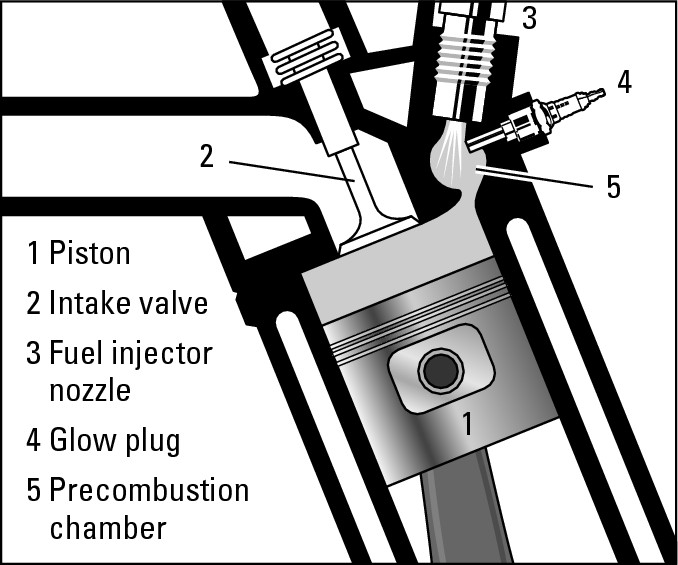
|
2. When everything is warm enough, a “Start” light goes on. When you see it, you step on the accelerator and turn the ignition key to “Start.”
3. Fuel pumps deliver the fuel from the fuel tank to the engine. On its way, the fuel passes through a couple of fuel filters (see Figure 9-3) that clean it before it can get to the fuel injector nozzles (see Figure 9-4). Proper filter maintenance is especially important in diesels because fuel contamination can clog up the tiny holes in the injector nozzles.
|
Figure 9-3: A diesel fuel filter. |
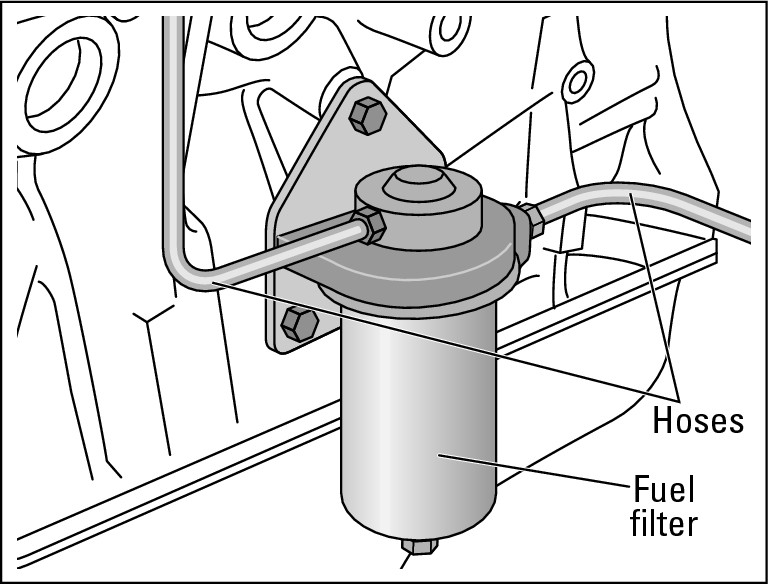
|
|
Figure 9-4: Anatomy of a fuel injector. |
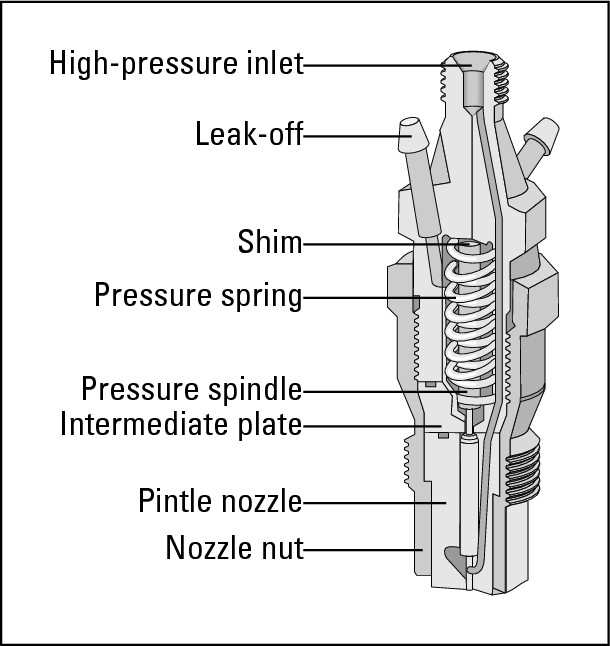
|
4. In the most common type of modern diesel fuel system, called common rail direct injection (CDI) and shown in Figure 9-5, the fuel injection pump pressurizes fuel into a delivery tube called a rail and keeps it there under constant high pressure of 23,500 pounds per square inch (psi) or even higher while it delivers the fuel to each cylinder at the proper time. (Gasoline fuel injection pressure may be just 10 to 50 psi!) The fuel injectors feed the fuel as a fine spray into the combustion chambers of the cylinders through nozzles controlled by the engine’s engine control unit (ECU), which determines the pressure, when the fuel spray occurs, how long it lasts, and other functions.
Other diesel fuel systems use hydraulics, crystalline wafers, and other methods to control fuel injection, and more are being developed to produce diesel engines that are even more powerful and responsive.
5. At this point, the action moves to the cylinders, where the fuel, air, and “fire” meet. While the preceding steps get the fuel where it needs to go, another process runs simultaneously to get the air where it needs to be for the final, fiery power play.
On conventional diesels, the air comes in through an air cleaner that’s quite similar to those in gas-powered vehicles. However, modern turbochargers can ram greater volumes of air into the cylinders and may provide greater power and fuel economy under optimum conditions. A turbocharger can increase the power on a diesel vehicle by 50 percent while lowering its fuel consumption by 20 to 25 percent!
6. Combustion spreads from the smaller amount of fuel that’s placed under pressure in the precombustion chamber to the fuel and air in the combustion chamber itself.
|
Figure 9-5: A common rail fuel injection system. |
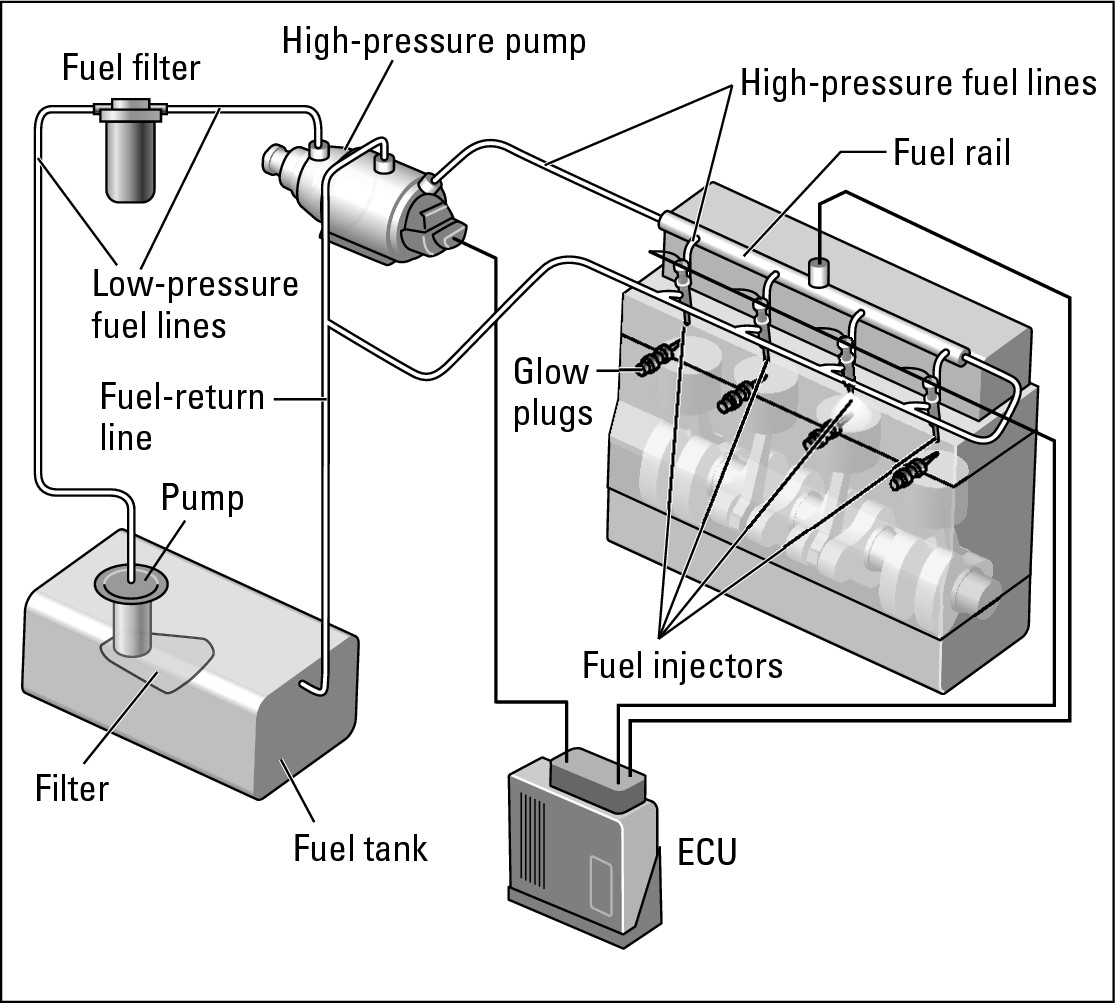
|
The Fuel System
The fuel system in a diesel engine performs the same functions as it does in gas-powered engines and consists of many of the same parts. After the fuel gets to the cylinders, however, there’s a difference in the four-stroke power cycle that converts it into the power to drive the vehicle. The next section provides a closer look at that cycle.
The diesel four-stroke power cycle
Although some smaller diesel engines (on motorcycles and marine engines, for instance) operate with two-stroke power cycles, most automotive diesel engines use a four-stroke power cycle, which is similar to, but not the same as, the power cycle of a gasoline engine (see Chapter 7). Here’s how the diesel’s four-stroke power cycle works:
 Stroke 1: Intake stroke (see Figure 9-6). The
piston
descends, the
intake valve
opens, and air is drawn into the cylinder.
Stroke 1: Intake stroke (see Figure 9-6). The
piston
descends, the
intake valve
opens, and air is drawn into the cylinder.
|
Figure 9-6: Intake stroke. |
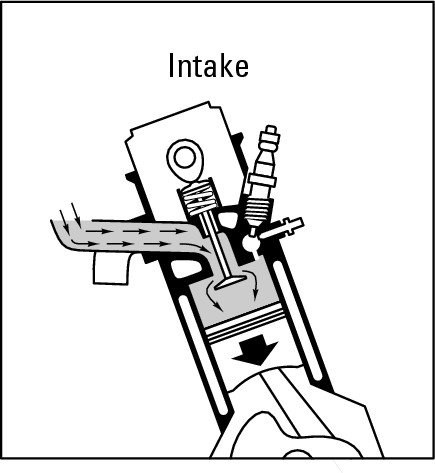
|
 Stroke 2: Compression stroke (see Figure 9-7). The intake and
exhaust valves
are closed as the piston moves upward and places the air under extreme pressure. As the pressure increases, the air heats up to the flash point (the point at which it causes the fuel to undergo spontaneous combustion). Just before the flash point is reached,
fuel injectors
spray fuel into the
combustion chambers
at the precise instant when ignition is to take place.
Stroke 2: Compression stroke (see Figure 9-7). The intake and
exhaust valves
are closed as the piston moves upward and places the air under extreme pressure. As the pressure increases, the air heats up to the flash point (the point at which it causes the fuel to undergo spontaneous combustion). Just before the flash point is reached,
fuel injectors
spray fuel into the
combustion chambers
at the precise instant when ignition is to take place.
|
Figure 9-7: Compression stroke. |
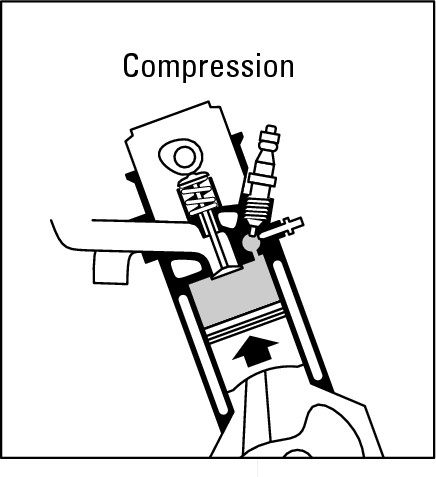
|
 Stroke 3: Power stroke (see Figure 9-8). With the intake valve and the
exhaust valve
closed, the fuel ignites, and combustion forces the piston down. This driving power is transmitted through the
transmission
and the rest of the
drive train
to the wheels, causing the vehicle to move.
Stroke 3: Power stroke (see Figure 9-8). With the intake valve and the
exhaust valve
closed, the fuel ignites, and combustion forces the piston down. This driving power is transmitted through the
transmission
and the rest of the
drive train
to the wheels, causing the vehicle to move.
|
Figure 9-8: Power stroke. |
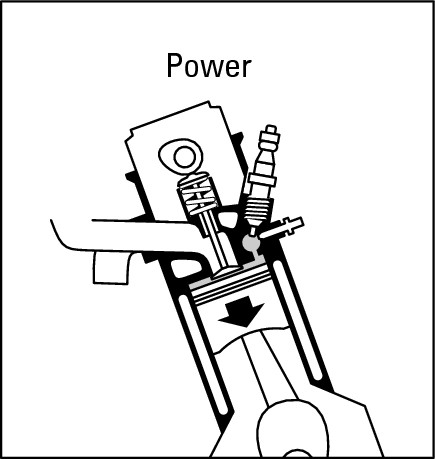
|
 Stroke 4: Exhaust stroke (see Figure 9-9). The exhaust valve opens as the piston rises and pushes the burned gases out of the cylinder.
Stroke 4: Exhaust stroke (see Figure 9-9). The exhaust valve opens as the piston rises and pushes the burned gases out of the cylinder.
|
Figure 9-9: Exhaust stroke. |
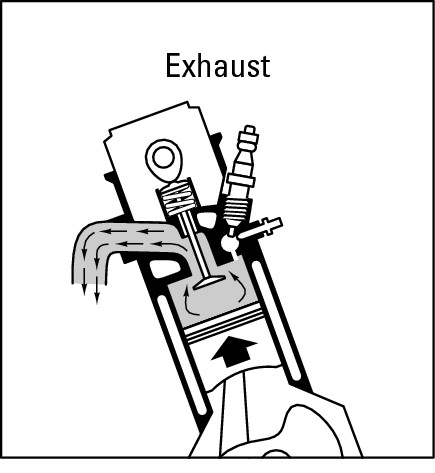
|
Diesel fuel
Diesel engines run on diesel fuel, which is more efficient than gasoline because it contains 10 percent more energy per gallon than gasoline. It’s also safer than gasoline because its vapors don’t explode or ignite as easily as gasoline vapors.

Standard diesel fuel

Standard diesel fuel (sometimes called diesel oil) comes in two grades: Diesel #1 (or 1-D) and Diesel #2 (or 2-D). Just as gasoline is rated by its octane, diesel fuel is rated by its cetane, which indicates how easy it is to ignite and how fast it burns. The higher the cetane number, the more volatile the fuel. Most diesel vehicles use fuel with a rating of 40 to 55. You won’t have to worry about which type to use because all diesel automakers specify Diesel #2 for normal driving conditions. Truckers use Diesel #2 to carry heavy loads for long distances at sustained speeds because it’s less volatile than Diesel #1 and provides greater fuel economy.

Diesel fuel also is measured by its viscosity, which has to do with its thickness and ability to flow. Like any oil, diesel fuel gets thicker and cloudier at lower temperatures. Under extreme conditions, it can become a gel and refuse to flow at all. Diesel #1 flows more easily than Diesel #2, so it’s more efficient at lower temperatures. The two types of oil can be blended, and most service stations offer diesel fuel blended for local weather conditions.

.jpg)

Biodiesel fuel
Biodiesel fuels derived from agricultural materials have the potential to provide a clean-burning alternative to dwindling sources of petroleum.
Rudolph Diesel’s first engine was designed to run on peanut oil, and Henry Ford envisioned plant-based fuel as the primary fuel for transportation and partnered with Standard Oil to develop biofuel production and distribution. However, as this book goes to press, the only type of biodiesel fuel that can be used in vehicles in the United States and Canada without violating manufacturer’s warranties is B5, a blend of 5 percent biodiesel and 95 percent regular diesel. Most diesel engines run just fine on blends of up to 30 percent biodiesel.
For higher blends, the engine control unit’s (ECU) electronic fuel “mapping” system, which regulates timing, fuel/air mixture, and so on, has to be reprogrammed to perform efficiently. The reason is that, although there’s no mechanical difference between a diesel engine that runs on diesel oil and a biodiesel-burning engine, biodiesel has slightly different energy and burning characteristics than regular petroleum-based diesel.
.jpg)
Emergency substitutes
Theoretically, diesel engines should be able to run on kerosene, certain airplane fuels, biodiesel in all blends between 5 percent and 100 percent, and home heating oil, but the key word here is “theoretically.” Do not use these oils in your vehicle except in absolute emergencies. Standards of refining, filtering, and blending these oils differ widely, and they can ruin your engine, void your warranties, and create a whole lot of trouble for you.
If you find yourself low on fuel in a remote area, look for trucking companies, food-processing plants, electric plants, hospitals, and farms. These places usually have diesel engines on the premises, and some good Samaritan may take pity on you and let you have some.
If you absolutely can’t find a source of diesel fuel, as a last resort borrow some home heating oil or buy some Jet-A fuel at a local airport. Diesel mechanics consider these substitutes to be like rotgut whiskey — it will get you there, but it’s not the best stuff for your system! Drive on these fuels only long enough to get to the nearest source of proper fuel.
The Electrical System
Diesels require more stored energy for starting than gasoline vehicles do, especially on cold days. Instead of just using the battery to enable the starter to crank the engine, a diesel must have sufficient power to enable the glow plugs to warm the combustion chambers and then must build up enough heat and compression in the cylinders to ignite the fuel. For this reason, diesels must possess considerably more battery capacity than conventional vehicles. Some diesels come equipped with two batteries; others feature a single oversized battery that may be more than 50 percent bigger than one found on a conventional vehicle. You can find instructions for jump-starting diesel batteries in the section “Caring for Your Diesel” later in this chapter.
Aside from this battery issue, electrical systems on diesels are pretty much the same as those on conventional vehicles; alternators, solenoids, and starters perform their usual functions. For information about these components, turn to Chapter 5.
The Emissions System
Along with much cleaner fuel, automakers are transforming the old, toxic diesels into vehicles with clean exhaust emissions by making dramatic changes to their emissions control systems. As of 2007, all diesels sold in the U.S. were clean diesels, and they’ll continue to get cleaner each year as new technologies for exhaust cleansing are developed. California has led the way in this area of change, and each year more and more states adopt its standards, which are stricter than those set by the federal government. Hopefully, the federal government will raise its standards as high as California’s (or higher!) as time goes on.
The first innovations in cleaner diesel emissions systems were the additions of the following components (you can see them in Figure 9-1):
 A diesel oxide
catalytic converter
that cleans hydrocarbons from the exhaust stream
A diesel oxide
catalytic converter
that cleans hydrocarbons from the exhaust stream
 A diesel particulate filter (see Figure 9-10) that scrubs sooty particles from the exhaust, trapping them in the filter material and regularly hitting the filter with a burst of superheated gasses to burn up the particles
A diesel particulate filter (see Figure 9-10) that scrubs sooty particles from the exhaust, trapping them in the filter material and regularly hitting the filter with a burst of superheated gasses to burn up the particles
|
Figure 9-10: A diesel particulate filter. |
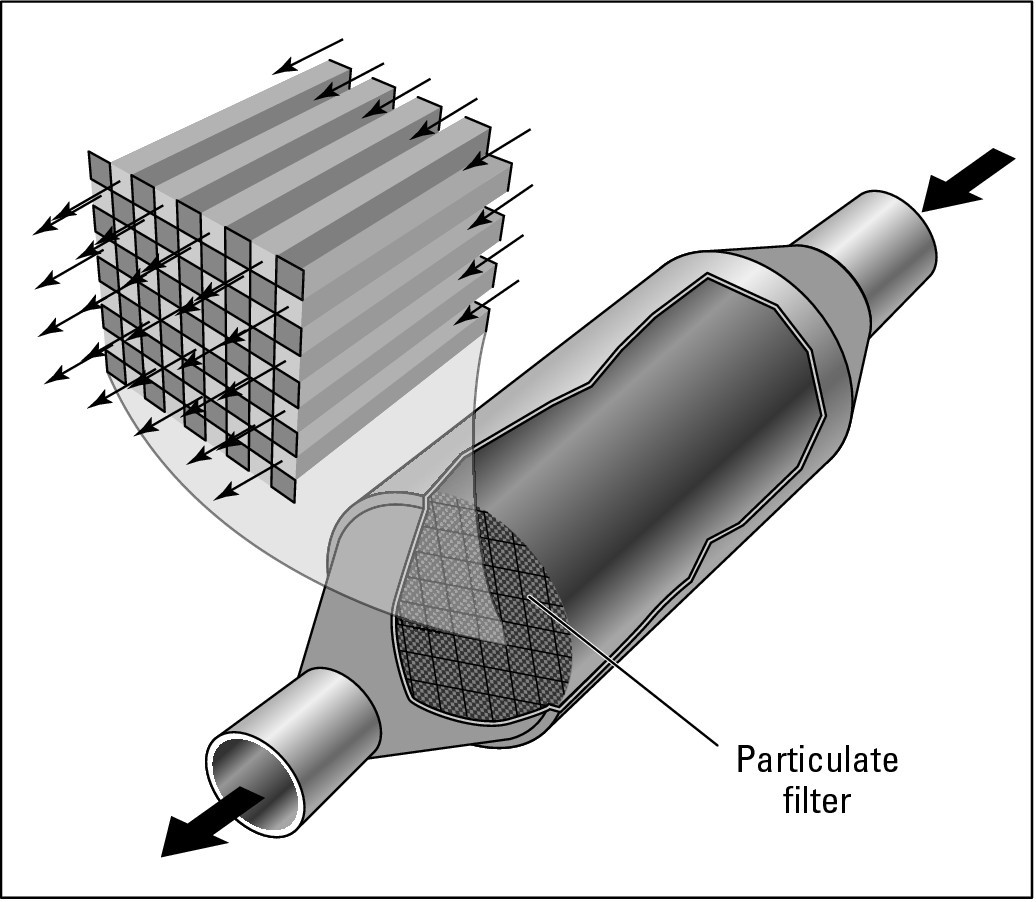
|
A number of automakers have introduced additional emissions traps to their diesel passenger vehicles and light trucks. Here are two systems:
 One system injects a mist of urea (a type of ammonia) that’s nontoxic, odorless, and biodegradable into the exhaust stream, where it bonds to toxic
NOx
emissions
(nitrogen oxides) and breaks them down to nitrogen and water. Then the exhaust flow carries the residue into a selective reduction catalyst (SRC) where it’s burned away. The urea container must be refilled regularly, usually with each scheduled mechanical checkup.
One system injects a mist of urea (a type of ammonia) that’s nontoxic, odorless, and biodegradable into the exhaust stream, where it bonds to toxic
NOx
emissions
(nitrogen oxides) and breaks them down to nitrogen and water. Then the exhaust flow carries the residue into a selective reduction catalyst (SRC) where it’s burned away. The urea container must be refilled regularly, usually with each scheduled mechanical checkup.
 The other system uses a new type of plasma catalyst to superheat and convert the NOx emissions into ammonia and then into harmless nitrogen gas.
The other system uses a new type of plasma catalyst to superheat and convert the NOx emissions into ammonia and then into harmless nitrogen gas.
Caring for Your Diesel
Regular maintenance is absolutely imperative if you want a diesel engine to last, and every diesel owner will probably encounter some pitfalls and problems. This section helps you deal with maintenance and repair issues — whether or not you choose to do the work yourself.
Although diesel engines require no ignition tune-ups and tend to last longer without major repairs than gasoline engines, they do require regular low-cost maintenance, mostly in the form of frequent oil and filter changes. The urea injection systems that reduce NOx emissions (see the previous section) also need refilling, which is usually done as part of regularly scheduled maintenance.
.jpg)

Most diesels are designed so that the owner can perform regular maintenance chores without an undue investment of time and money. The following sections cover these tasks in general terms; your owner’s manual should contain the rest of the information you need.

Changing the lubricating oil
Because diesel fuel is sometimes called diesel oil, be aware that the oil you have to change is not the fuel oil but the oil that lubricates the engine. This job requires lubricating oil that’s specially designed for diesel engines — not gasoline engines. After you understand that distinction, the actual work involved is the same as it is for conventional vehicles except that you have to do the task more often on a diesel.


Because the procedure is the same, all the instructions for changing oil and oil filters in Chapter 13 are relevant for diesels except for the oil classification codes. (The classification codes for automotive oils tell you which oil to use under a specific set of conditions.) Figure 9-11 shows what the API classification code symbol looks like on containers of diesel oil from reliable manufacturers.
|
Figure 9-11: The API symbol for diesel oil. |
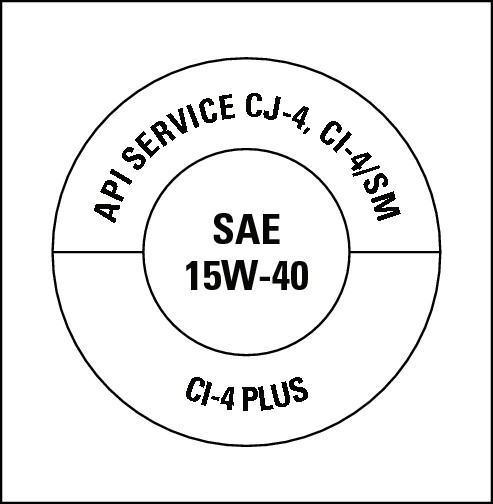
|
As new and improved oils appear on the market, these codes have changed from the original CA to CB to CC, and so on. Each new level can replace previous ones, and the earliest oils are considered obsolete. Unless your vehicle is several years old, your owner’s manual will list the proper API category oil to use. The manual also specifies a viscosity grade in the form of a number preceded by the initials “SAE.” This grade refers to the “weight” of the oil and the temperature conditions under which it will flow. Diesel lubricating oil comes in the same range of weights as oil for conventional vehicles, and you can find additional information on that in Chapter 13.

Changing the air filter
The air filter setup on most diesels is the same as on gasoline-powered vehicles, with the filter located inside the cold air collector box located under the hood. You can find directions for reaching the air filter in Chapter 8.
.jpg)
Changing the fuel filters
Most diesels have two fuel filters: a “primary” filter located between the fuel tank and the engine, which cleans the fuel before it gets to the fuel transfer pump; and a “secondary” filter up near the engine, which gives the fuel a final cleaning before it gets to the fuel injectors. Both are usually easy to change, and your owner’s manual should show you how to do this job. On some diesels, the job is much like changing the oil filter on a conventional vehicle: You unscrew the old one, moisten the gasket of the new one with fuel, and screw it into place. Others have filters with replaceable cartridges; you just remove the old one and pop in the new one. There’s one catch to changing the fuel filter, however, and the next section has the details.
Bleeding and priming the fuel system
When you change the fuel filter or run out of fuel in a diesel vehicle, you must bleed the air bubbles out of the fuel system and then prime it to get a new supply of fuel circulating. Cranking the engine does the job but also wears down the battery, so most diesels include a manual primer pump and an air-bleed screw for the purpose of bleeding the system and priming it. On many vehicles, you simply pump the primer’s handle to get the fuel moving, and then you turn the air-bleed screw until a hissing noise tells you that the air is escaping. Just keep pumping until all the air leaves and the noise ceases; then tighten the air-bleed screw and replace the pump handle.

Draining water separators
Diesel fuel can easily become contaminated by water because diesel fuel absorbs water more than gasoline does. For this reason, many diesel vehicles feature a gadget called a water separator that collects water from the fuel. It’s usually located on or near the fuel filter. If your vehicle doesn’t have one, I strongly suggest that you have one installed. The part shouldn’t be terribly expensive, and it can save you a bunch of money on repairs.
Although a few water separators are self-cleaning, most need to be manually drained: You just turn a little drain valve called a petcock and empty the water from the collection chamber of the separator.

Jump-starting diesel batteries
Even though diesel-powered vehicles can have dual batteries or one oversized battery (refer to the earlier section, “The Electrical System”), it’s possible to jump-start a diesel from the battery on a conventional gasoline-powered vehicle.

1. Make sure that both vehicles are in Park or Neutral with the parking brakes on.
2. Turn on the heater on the disabled diesel vehicle to protect the electrical system from surges in voltage.
3. Make sure that the lights and other electrical accessories on the disabled diesel vehicle are off.
4. A vehicle with dual batteries usually has thicker cables on one of the batteries. If either vehicle has dual batteries, always attach the jumper cables to the battery with thicker cables.
If either vehicle has dual batteries with cables of the same thickness, use either battery for the jump. If a vehicle has only one battery, just be sure to hook the cables up in the proper order.
.jpg)
5. Connect the clamp on one of the jumper cables to the positive terminal of the disabled vehicle’s battery.
The positive terminal should have a (+) or a red cover on it.
6. Connect the other end of the same jumper cable to the positive terminal of the source vehicle.
7. Connect one end of the other jumper cable to the negative terminal (-) of the source vehicle.
8. Here’s the tricky part: Connect the other end of that jumper cable to an unpainted, metallic part of the disabled vehicle.
I often use the bracket that keeps the hood up, but any such part will do as long as it’s not near the battery, belts, or any other moving parts of the engine.
9. Start the engine on the source vehicle.
10. Start the engine on the disabled vehicle, and let both engines run for a minute or two, more if the battery has been dead for a long time.
11. Turn off the engine of the source vehicle. (Leave the disabled vehicle’s engine running.)
12. Remove the cable from the unpainted metal part of the disabled vehicle.
13. Disconnect the cable from the positive terminals of both vehicles.
14. Disconnect the cable from the negative terminal of the source vehicle.
15. The disabled vehicle should be driven around for at least 15 minutes to ensure that the battery is fully charged.

Getting Started on a Frosty Morning
Diesel drivers everywhere are thankful that diesels have become easier to start in cold weather. Most turn over within 1.5 seconds of turning on the ignition.
Metal cylinder walls become very cold when the temperature drops, so most vehicles are harder to start in cold weather. Because diesel engines require much higher temperatures to fire the fuel, they’ve always been harder to start in cold weather than gasoline-powered vehicles. To warm things up before the engine can run, a variety of heaters have been developed that keep various parts of the vehicle warm and snuggly even when it isn’t being driven. Some of these gadgets may be on the vehicle when you buy it; others you can buy and install later on if the need for them arises.

Block heaters
Many diesels come equipped with built-in electric-powered block heaters to keep the engine block warm overnight. You just park the vehicle, plug the heater cord into a heavy-duty three-pronged extension cord, and then plug the extension cord into a 110-volt electrical socket that can handle a three-pronged plug. When shopping, don’t skimp on the length of the extension cord — it can be 50 feet to a socket from a motel parking lot! I’ve been told that in Alaska, where a block heater is vital, electrical outlets are built right into some parking meters. I doubt that anyone tries to beat those meters, especially at –40°F!
If your vehicle doesn’t have a block heater, you can buy one and have it installed. Various types are available, but immersion -type heaters are the most popular.
.jpg)
Battery warmers
If your diesel doesn’t start in cold weather and you remembered to plug in the block heater, your battery may be the culprit. Batteries can lose 35 percent of their power at 32°F and as much as 60 percent at 0°F. Because the battery has to supply the glow plugs with sufficient juice to get things warmed up (refer to the earlier section, “What Makes It Go?”), a frostbitten battery isn’t of much use on an icy morning.

 The “hot plate” warmer, which simply slides under the battery like a cookie sheet and warms its little toesies.
The “hot plate” warmer, which simply slides under the battery like a cookie sheet and warms its little toesies.
 The “electric blanket” warmer, which wraps around the battery and uses more current than the hot plate version to deal with really frigid situations.
The “electric blanket” warmer, which wraps around the battery and uses more current than the hot plate version to deal with really frigid situations.
Oil warmers
You can buy a heated dipstick to heat the oil in the engine crankcase (you just trade it for your normal dipstick and plug it into an electrical outlet) and a host of other gadgets to warm the coolant in the engine and the fuel in the fuel lines. (Most people don’t need all this stuff, but for my readers in Alaska, Canada, and other cold climates, I want to cover the subject thoroughly.)

What not to do on a frosty morning
.jpg)
Finding a Reliable Diesel Mechanic
If you need professional diesel maintenance or repair and your vehicle is out of warranty, you may want to check around for a good independent diesel mechanic so that you can compare prices with those of the dealership or get a second opinion on major surgery. One way to find a good independent diesel mechanic is to look in your local yellow pages under “Automobiles, Repair” (or something similar) for a shop whose ad carries the logo of the Association of Diesel Specialists (ADS). The ADS authorization goes to repair facilities that send their mechanics to factory schools for instruction, maintain standards of cleanliness, and meet requirements for stocking the tools and parts to deal properly with a variety of diesel systems. (Chapter 22 is devoted to finding and maintaining a good relationship with a mechanic; it also tells you how to get satisfaction on complaints about labor or services.)